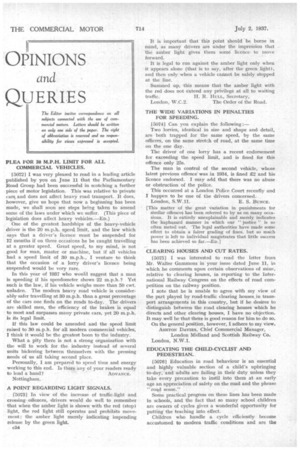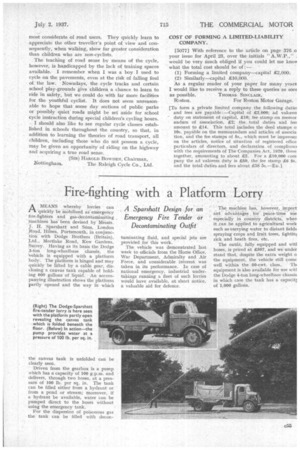OPINIONS
Page 100

Page 101

If you've noticed an error in this article please click here to report it so we can fix it.
and
QUERIES
The Editor invites correspondence on all subjects connected with the use of commercial motors. Letters should be written on only one side of the paper. The right of abbreviation is reserved and no responsibility for views expressed is accepted.
PLEA FOR 30 M.P.H. LIMIT FOR ALL COMMERCIAL VEHICLES.
150721 I was very pleased to read in a leading article published by you on June 11 that the Parliamentary Road Group had been successful in scotching a further piece of motor legislation. This was relative to private cars, and does not affect heavy road transport. It does, however, give us hope that now a beginning has been made, we shall soon see steps being taken to amend some of the laws under which we suffer, (This piece of legislation does affect heavy vehicles.—En.) One of the greatest hardships of the heavy-vehicle driver is the 20 m.p.h. speed limit, and the law which says that a driver's licence must be suspended for 12 months if on three occasions he be caught travelling at a greater speed. Great speed, to my mind, is not good for man, master or machine, but if all vehicles had. a speed limit of 30 m.p.h., I venture to think that the occasion of a lorry driver's licence being suspended would be very rare.
In this year of 1937 who would suggest that a man is speeding if his speedometer shows .22 m.p.h.? Yet such is the law, if his vehicle weighs more than 50 cwt. unladen. The modern heavy road vehicle is considerably safer travelling at 30 m.p.h. than a great percentage of the cars one finds on the roads to-day. The drivers are skilled men, the efficiency of the brakes is equal • to most and surpasses many private cars, yet 20 m.p.h. is its legal limit.
• If this law could be amended and the speed limit raised to 30 m.p.h. for all modern commercial vehicles, I think it would be the greatest boon to the industry. What a pity there is not a strong organization with the will to work for the, industry instead of several units bickering between themselves with the pressing needs of us all taking second place.
Personally, I am prepared to spend time and energy working to this end. Is there any of your readers ready to lend a hand? Are/Amex. Nottingham.
A POINT REGARDING LIGHT SIGNALS.
r50731 In view of the increase of traffic-light and crossing offences, drivers would do well to remember that when the amber light is shown with the red (stop) light, the red light still operates and prohibits movement: the amber light merely indicating impending release by the green light.
ct54 It is important that this point should be borne in mind, as many drivers are under the impression that the amber light gives them some licence to rnoVe forward.
• It is legal to run against the amber light only when • it appears alone (that is to say, after the green light), and then only when a vehicle cannot be safely stopped at the line.
. Summed up; this means that the amber light with the red does not extend any privilege at all to waiting traffic. H. R. HULL, Secretary, London, W.C.2. The Order of the Road.
THE WIDE VARIATIONS IN PENALTIES FOR SPEEDING.
[5074] Can you explain the following:—
Two lorries, identical in size and shape and detail, are both trapped for the same speed, by the same officers, on the same stretch of road, at the same time on the one day.
The driver of one lorry has a recent endorsement for exceeding the speed limit, and is fined for this offence only 25s.
The man in control of the second vehicle, whose latest previous offence was in 1934, is fined £2 and his licence endorsed. I may add that there was no abuse or obstruction of the police.
This occurred at a London Police Court recently and I happen to be one of the drivers concerned.
London, S.W.11. E. S. BUNCE.
[This matter of the great variation in punishments for similar offences has been referred to by us on many occa
sions. It is entirely unexplainable and merely indicates the haphazard manner in which our " justice " is so often meted out. The legal authorities have made some effort to obtain a fairer grading of fines, but so much power is left to individual magistrates that little success has been achieved so far.—ED.]
CLEARING HOUSES AND CUT RATES.
[50751 I was interested to read the letter from Mr. Walter Gammons in. your issue dated June 11, in which he comments upon certain observations of mine, relative to clearing houses, in reporting to the International Railway Congress on the effects of road competition on the railway position.
I note that he is unable to agree with my view of the part played by road-traffic clearing houses in transport arrangements in this country, but if he desires to distinguish between the road clearing houses which he directs and other clearing houses, I have no objection. It may well be that there is good reason for him to do so. On the general position, however, I adhere to my view. ASHTON DAVIES, Chief Commercial Manager, London Midland and Scottish Railway Co. London, N.W.1.
EDUCATING THE CHILD-CYCLIST AND PEDESTRIAN.
[5076] Education in road behaviour is an essential and highly valuable section of a child's upbringing to-day, and adults are failing in their duty unless they take every precaution to instil into them at an early age an appreciation of safety on the road and the phrase " road sense."
Some practical progress on these lines has been made in schools, and the fact that so many school children are owners of cycles gives a wonderful opportunity for putting the teaching into effect.
Children who handle a cycle efficiently become accustomed to modern traffic conditions and are the most considerate of road users. They quickly learn to appreciate the other traveller's point of view and consequently, when walking, show far greater consideration than children who are non-cyclists.
. The teaching of road sense by means of the cycle, however, is handicapped by the lack of training spaces available. I remember when I was a boy. I used to cycle on the pavements, even at the risk of falling foul of the law. Nowadays, the cycle tracks and certain school play-grounds give children a chance to learn to ride in safety, but we could do with far more facilities for the youthful cyclist. It does not seem unreasonable to hope that some day sections of public parks or possibly quiet roads might be set aside for school cycle instruction during special children's cycling hours.
I should also like to see regular cycle classes established in schools throughout the country, so that, in addition to learning the theories of road transport, all children, including those who do not possess a cycle, may be given an opportunity of riding on the highway and acquiring a true road sense.
(Sm.) HAROLD BOWDEN, Chairman.,
Nottingham. The Raleigh Cycle Co., Ltd. COST OF FORMING A LIMITED-LIABILITY COMPANY.
[5077] With reference to the article on page 376 o your issue for April 23, over the initials " A.W.P.," would be very much obliged if you could let me knot.' what the total cost should be of:
(1) Forming a limited company—capital £2,000.
(2) Similarly—capital £10,000.
As a regular reader of your paper for many years I would like to receive a reply to these queries as sacs
as possible. THOMAS SINCLAIR, Reston. For Reston Motor Garage.
[To form a private limited company the following dutica and fees are .payable : —Capital of £2,000; ad valoren duty on statement of capital, £10; fee stamp on memor andum of association, £2; the, total duties and lee amount to £14. This total includes the deed stamps o 10s. payable on the memorandum and articles of associa tion, and the fee stamps of 5s.,• which must be impresser on the articles, notice of situation of registered office particulars of directors, and declaration of compliancr with the requirements of The Companies Act, 1929, these together, amounting to about £2. For a 210,000 corn pany the ad valorem duty is £50, the lee stamp £6 5s.
and the total duties and fees about £58 5s .




















































































































































